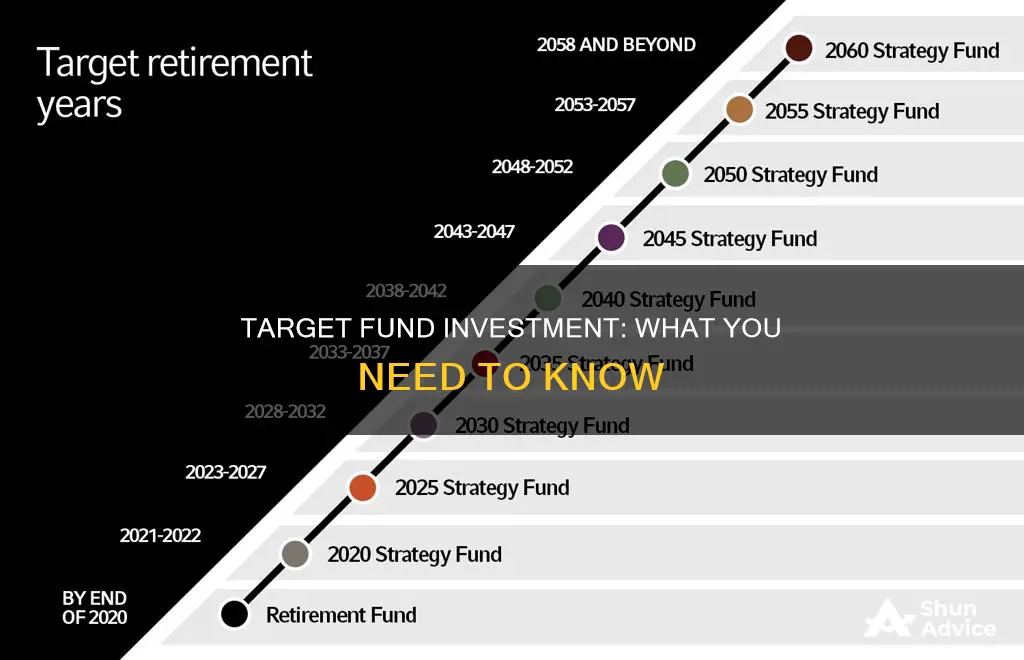
Target-date funds (TDFs) are a type of investment fund designed for long-term savings, often for retirement. They are sometimes referred to as life-cycle funds, target retirement funds, or age-based funds. The concept is simple: an investor chooses a fund with a target date that corresponds to their planned retirement year and puts money into the fund, which is then adjusted over time to optimize returns and reduce risk as the target date approaches. TDFs are designed to be the only investment vehicle an investor uses to save for retirement, offering a simple way to gain exposure to a variety of markets and asset allocation strategies. While TDFs are popular, they have pros and cons that need to be carefully considered.
| Characteristics | Values |
|---|---|
| Type of investment | Long-term |
| Type of fund | Mutual fund |
| Investment style | Actively managed |
| Investment type | Bonds, stocks, fixed-income investments, money market accounts |
| Risk | High initially, gradually becomes more conservative |
| Management | Automatic, fund managers make decisions about asset allocation |
| Investment horizon | Until retirement |
| Investment goal | Wealth accumulation, retirement savings |
| Investor profile | Hands-off, not interested in constantly adjusting investments |
| Fees | Expense ratios, management fees |
What You'll Learn

Target-date funds are a set it and forget it retirement savings option
Target-date funds, also known as life-cycle funds or target-retirement funds, are a "set it and forget it" retirement savings option. They remove the headache of deciding on a mix of assets and rebalancing those investments over time. They are designed to be the only investment vehicle an investor uses to save for retirement.
Target-date funds are designed to age with you by automatically rebalancing your portfolio from growth investments toward more conservative ones as retirement nears. They aim to strike the right balance between the risk necessary to build wealth and safer bets to protect a growing nest egg. The fund automatically rebalances your portfolio with the right mix of stocks, bonds, money market accounts, and other investments as you age. While you set and forget, the fund updates your asset allocation through the years.
Early in your working life, a target-date fund is generally set for growth by having a much larger slice of your portfolio in stocks rather than fixed-income investments like bonds, which are safer but provide smaller returns. As your retirement year approaches, the fund gradually shifts toward more bonds, money market accounts, and other lower-risk investments.
Your retirement year is the "target date" of most of these funds, and the funds are conveniently named to correspond with your planned retirement year. For example, if you plan to retire in or near 2045, you would pick a fund with 2045 in its name.
The chief appeal of target-date funds is their simplicity. They put all the ingredients of a good investment together for you, so you don't have to. Their convenience is a big reason many Americans already own target-date funds, although many may not know it. Target-date funds are the default plan of choice for many providers of employer-backed retirement plans such as 401(k) accounts.
Another advantage of target-date funds is that they keep investors from being too reactive to the market's twists and turns, which often results in buying high and selling low.
Growth Funds: Why You Should Invest Now
You may want to see also

Target funds are a type of mutual fund
Target funds are designed to be the only investment vehicle an investor uses to save for retirement. The idea is that an investor picks a fund, puts as much money into it as they can, and then leaves it until they reach retirement age. The fund's portfolio managers use a predetermined time horizon to fashion their investment strategy, which relies on riskier stocks in the early years, moving gradually towards fixed-income investments like bonds in later years. This shift in asset allocation is known as the fund's glide path.
Target funds are offered by many company 401(k) plans and are also an option for people investing in individual retirement accounts (IRAs). They are often the default investment option for employees who have not selected their own investments under a 401(k) plan.
Retirement Planning: 401(k) vs Mutual Funds for Your Future
You may want to see also

Target funds are also known as life-cycle funds
Target funds, also known as life-cycle funds or target-retirement funds, are a "set it and forget it" retirement savings option. They are designed to age with you by automatically rebalancing your portfolio from growth investments toward more conservative ones as retirement nears. They aim to strike the right balance between the risk necessary to build wealth and safer bets to protect a growing nest egg.
Target-date funds are a popular choice among investors for retirement savings. They are designed to be the only investment vehicle that an investor uses to save for retirement. The concept is simple: pick a fund, put as much as you can into the fund, then forget about it until you reach retirement age. Of course, nothing is ever as simple as it seems. While simplicity is one of the pros of these funds, investors still need to stay on top of fees, asset allocation, and the potential risks.
Target-date funds are offered by many company 401(k) plans and are also an option for people investing in individual retirement accounts (IRAs). They are a common preset choice for a 401(k) and are the default plan of choice for many providers of employer-backed retirement plans. They are also known as age-based funds.
Target-date funds are a long-term investment account that is automatically adjusted over the years as the investor approaches a specific milestone, such as retirement. They are designed to invest heavily in riskier growth stocks in the early years to rack up gains while the investor has plenty of time to recover from any short-term losses. In later years, the investment choices lean toward more conservative choices to consolidate gains and avoid untimely losses. The asset allocation of a target--date fund gradually shifts to more conservative investment choices, reducing the risk of losses as the target date approaches.
Target-date funds may be a quick-meal approach to portfolio management, but recipes and ingredients can vary widely across your menu of offerings. One feature of all target-date funds is their "glide path," or how the funds descend from a high ratio of riskier equity funds toward safer investments like bonds, and then land, freezing your asset allocation at its most conservative mix to protect your nest egg.
Setting Up an Investment Fund: Switzerland's Guide
You may want to see also

Target funds are designed to be long-term investments
Target funds, also known as target-date funds, are designed to be long-term investment accounts. They are often used for retirement savings and are therefore also known as target-date retirement funds or target retirement funds. The idea is that an investor picks a fund with a target date based on their investment goal, such as retirement in 2045, and puts as much money as they can into the fund. The fund is then left alone until the target date is reached.
Target funds are designed to be the only investment vehicle an investor uses to save for retirement. They are a simple way to save for retirement, offering exposure to a variety of markets, active and passive management, and a selection of asset allocation options. They are also popular with 401(k) plan investors, particularly those who don't have the time or inclination to review their fund's holdings annually and revise their investment strategy.
Target funds are designed to invest heavily in riskier growth stocks in the early years, with the aim of racking up gains while the investor has plenty of time to recover from any short-term losses. As the target date approaches, the investment choices lean towards more conservative options to consolidate gains and avoid untimely losses. This is known as the fund's glide path. The fund's portfolio managers use a predetermined time horizon to fashion their investment strategy according to a standard long-term asset allocation strategy.
The chief appeal of target funds is their simplicity. They are a "set it and forget it" retirement savings option that removes the headache of deciding on a mix of assets and rebalancing those investments over time. However, investors who use target funds need to stay on top of asset allocation, fees, and investment risk.
Mutual Fund Investment: Tracking and Monitoring Basics
You may want to see also

Target funds are designed to age with you
Target funds are designed to be long-term investments that age with you, shifting from aggressive to conservative investments as you near your retirement age. This makes them a "set it and forget it" option for retirement savings.
Target-date funds, also known as life-cycle funds or target-retirement funds, aim to strike a balance between the risk necessary to build wealth and safer investments to protect your savings. They do this by automatically rebalancing your portfolio as you age.
In the early years, target funds are set for growth, with a large slice of your portfolio in stocks. As retirement nears, the fund shifts towards more conservative investments, such as bonds, money market accounts, and other lower-risk options. This is known as the fund's glide path.
The target date is usually included in the fund's name, making it easy to choose a fund that matches your planned retirement year. For example, if you plan to retire in 2045, you would choose a fund with 2045 in its name.
The chief appeal of target funds is their simplicity. They offer a diverse portfolio of assets that is automatically adjusted over time, removing the need for investors to actively manage their investments. However, it's important to remember that all target funds are not created equal, and it's essential to do your research before investing.
Norway's Wealth Fund: A Guide to Investing
You may want to see also
Frequently asked questions
A target fund investment, also known as a target-date fund (TDF), is a long-term investment account that is automatically adjusted over time as the investor approaches a specific milestone, such as retirement. Target funds are designed to be the only investment vehicle an investor uses to save for retirement.
Target funds are designed to invest heavily in riskier growth stocks in the early years to rack up gains while the investor has time to recover from any short-term losses. As the target date approaches, the fund choices lean towards more conservative investments to consolidate gains and avoid untimely losses.
Target funds offer a simple way to save for retirement, providing exposure to a variety of markets, active and passive management, and a selection of asset allocation options. They are also popular with 401(k) plan investors, particularly those who don't have the time or inclination to review their fund's holdings regularly.







